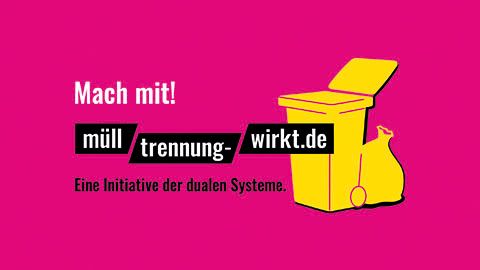Efficient recycling is the future and the throwaway society will hopefully be a thing of the past. Only with rethinking and concrete solutions we can ensure that the environment is protected in the long term and that sufficient resources and raw materials are available to future generations. This is a key reason why the Green Dot has chosen “Take it and shape it” as a maxim.
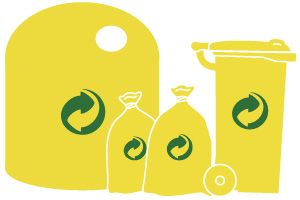
When the Packaging Ordinance obliged industry and commerce to take back and reuse their packaging, trade and industry founded the Green Dot as a second (dual) system alongside the public waste disposal system. Since 1991, we have been collecting packaging waste and using it to extract secondary raw materials that flow back into the economic cycle. And with success! In 2017, the companies with the Green Dot recycled around 1.8 million tonnes of waste, and through recycling we avoided 1.1 million tonnes of emissions of CO2 equivalents. The future also sounds promising: every year the dual system Der Grüne Punkt fulfills the quotas from the Packaging Ordinance and even surpasses them.
Waste separation. This is how we can achieve a clean future!
Waste separation, i.e. the separation of valuable materials, is essential for efficient recycling. In Germany, most households have collection containers for five different types of waste: glass, paper and cardboard, lightweight packaging (LWP) made of plastic, aluminum, tinplate and composite materials, as well as residual waste and biowaste. And basically, trash sorting is quite simple: paper, cardboard and cardboard packaging belong into the waste paper collection; color-sorted bottles and container glass into the dropoff containers (please put blue glass into the green glass container!). In the yellow bin or the yellow sack only light weight packaging made of metal, composite material and plastic is collected. Residual waste and biowaste each have their own bins.
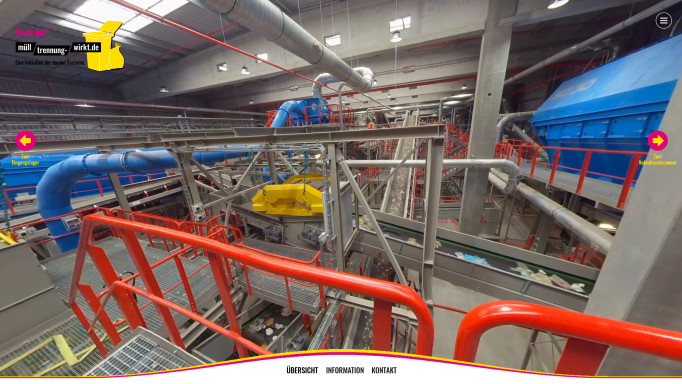
The inside of a sorting plant for packaging waste
Everything that is collected in the yellow bag and the yellow garbage can in Germany first goes to a special sorting plant. Unfortunately, only very few people know what happens in such a plant. With the 360-degree video of the Initiative Mülltrennung wirkt (Waste Separation Initiative), anyone with a computer or smartphone can now wander through such a state-of-the-art facility in Germany and view and explain each machine in detail (sorry, only in German language).
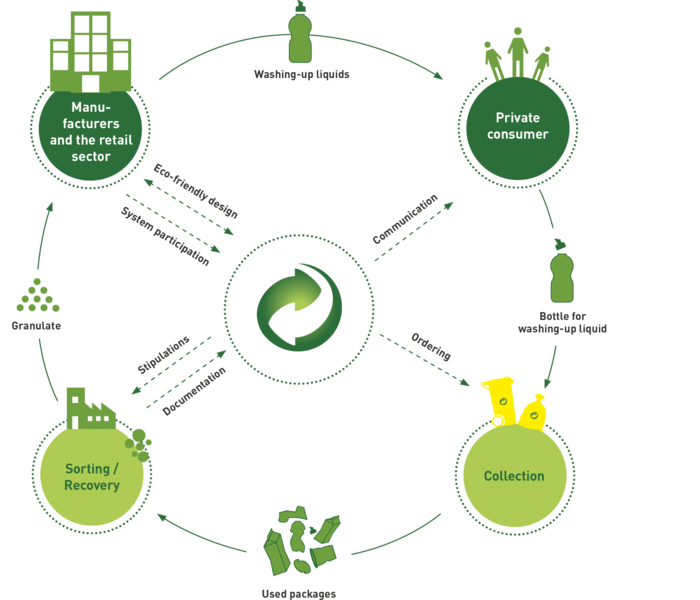
Nine dual systems are currently permitted in Germany, which use the yellow bins or bags, the dropoff containers for glass and paper barrels to collect used sales packaging. Der Grüne Punkt - Dual System Germany GmbH with the Green Dot as a trademark has been the first dual system to build this near-to-home collection system.
But what does waste separation do for the environment? Don't we end up using more energy through recycling than we save? How does the work of the Green Dot contribute to climate protection? To this end, the Green Dot prepares an annual environmental balance sheet that answers precisely these questions.
The Green Dot stands for producer responsibility
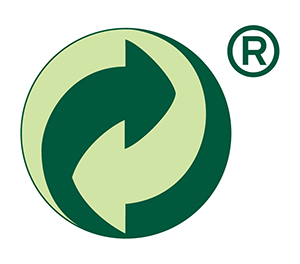
Consumers know the Green Dot as the well-known trademark of Der Grüne Punkt - Duales System Deutschland GmbH. It is protected in over 170 countries.
Dual systems like Der Grüne Punkt in Cologne organize the collection, sorting and recycling of used sales packaging for industry and trade throughout Germany. In doing so, they fulfill the so-called extended producer responsibility for the manufacturers of packaged products. According to the German Packaging Act, manufacturers are obliged to register their packaging placed on the market with a dual system so that this system collects the used packaging and sends it for recycling. This contract service costs and the manufacturer pays a so-called participation fee to its dual system.
If the Green Dot is printed on a package, the manufacturer thus indicates that it fulfills the obligations of the Packaging Act and takes responsibility for the recycling of its packaging. Printing the Green Dot on packaging is voluntary. Manufacturers who do so have concluded an additional trademark use contract for this purpose with the trademark owner, the Der Grüne Punkt in Cologne. A valid participation contract for their packaging with a dual system is a prerequisite. The imprint does not make any statement as to whether the packaging in question is recyclable and how it is recycled.
- The Green Dot on packaging is therefore a financing symbol and not an environmental symbol.
Important: Packaging with but also without a Green Dot may also be disposed of in the separate collection. How this works, you know for sure: glass in the glass containers, paper and cardboard in the waste paper collection and lightweight packaging made of plastic, metal and composites in the yellow sack or the yellow bin.
